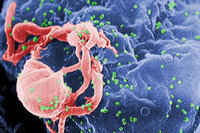Thirty years of AIDS deadly triumph, still no hope
 Thirty years ago, on June 5, 1981, the US Center for Disease Control and Prevention announced the discovery of a strange form of pneumonia. The disease was found among homosexual individuals. One of the symptoms of the disease included Kaposi's sarcoma, which is a typical ailment for the people with suppressed immune system. A year later, the disease was called AIDS. The virus that causes acquired immunodeficiency syndrome was called HIV - human immunodeficiency virus.
Thirty years ago, on June 5, 1981, the US Center for Disease Control and Prevention announced the discovery of a strange form of pneumonia. The disease was found among homosexual individuals. One of the symptoms of the disease included Kaposi's sarcoma, which is a typical ailment for the people with suppressed immune system. A year later, the disease was called AIDS. The virus that causes acquired immunodeficiency syndrome was called HIV - human immunodeficiency virus.
Thirty years later one may summarize the sad results of the activity of the virus. The disease has killed 30 million people in the world. About 33 million of people living in the world today are HIV-positive.
"I think (before AIDS) there was a feeling in the developed world that infectious diseases had run their course. We had conquered them with antibiotics and other things," James Curran, who headed the CDC's first task force on the mystery disease back in 1981 said. "AIDS reminded us there are new infectious problems - that infections can emerge and have an enormous impact. Once it became clear that it was in the blood supply and was caused by a virus, people went from total denial and complacency to much more of a panic mode," recalled Curran. "When those first five cases were reported, there were already 250,000 gay men in the U.S. who were infected with the virus."
A group of French researchers said in 1983 that the HIV virus could be transmitted only via blood, genital secretions and breast milk. They discovered that the virus was affecting the immune system causing tuberculosis or pneumonia. The disease was lethal before 1996. In 1996, a highly-efficient anti-virus therapy AZT was developed. Nowadays, HIV-positive individuals can lead normal lives, at least in the developed countries. Taboos and prejudices about AIDS begin to collapse, although not in Russia. Infected mothers can give birth to healthy babies.
The virus showed an enormous influence on the development of the human civilization. People all over the world began to use contraceptives, disposable syringes and other medical tools were invented. Medics all over the world had to revise the security system, especially during blood transfusion procedures. The struggle against the virus triggered the speedy development of virology. A huge step was made in developing new methods of treatment of viral hepatitis B and C. Other types of hepatitis were discovered as well.
AIDS is now considered a chronic, rather than a lethal disease. The virus kills less, but continues to spread. As many as 7,000 people become HIV infected in the world every day, the UN said. Only one in every third infected individual can access medications. As for Africa, the situation there is catastrophic. The number of HIV-positive people there makes up to 25 percent of the population, and they are mostly women.
It was originally believed that AIDS was a disease of homosexuals and drug addicts. Nowadays, the family couples that do not use contraceptives during sex, are also included in the risk group.
From the social point of view, people underestimate the disease in the world today. Many people got accustomed to the phenomenon of the disease. They consider AIDS/HIV a rare disease, which they prefer to ignore. Like 30 years ago, AIDS remains a shameful disease, which one should not talk about much.
From the scientific point of view, one has to achieve two important goals. They include the vaccine and the effective therapy. News reports about anti-AIDS vaccine appear in the media on the regular basis. However, traditional vaccines and therapy do not work when it comes to AIDS/HIV infection. The virus gets integrated into the genetic material of an infected individual. One needs genetic interference to destroy the virus.
Timothy Ray Brown, known as the "Berlin patient," was tested positive for HIV in 1995. He currently lives in San Francisco, but he was previously based in Berlin, Germany. Brown had HIV and leukemia. Brown received bone marrow from a donor immune to HIV. About 1 percent of Caucasians are immune to the virus, which means that those people can not catch the virus. The donor had the CCR5-Δ32 gene. This gene is resistant to AIDS. As a result of the transplant, Brown no longer has HIV. The cells of those immune to HIV, do not carry the CCR5 receptor protein on their surface. The HIV virus uses that block for infection. Scientists only need to create something to artificially stop the synthesis of the protein.
For the time being, many hope that there will be more efficient traditional therapy medications invented so that HIV-positive patients could take them at least four times a month, instead of several times a week. There are many of those who believe that mankind will never find a cure for AIDS. If no progress is achieved, as many as 60 million people will be HIV-positive by 2030.
As for Russia, there are approximately 600,000 HIV-positive people in the country. Their number has increased by 42 percent in 2010 as opposed to 2009. In some regions of the country, HIV-positive individuals make one percent of the population. The number of HIV-positive individuals among pregnant women and children also grows steadily. The average age of late HIV-positive Russians makes up 32 years. The number of HIV-related deaths grows as well: 11,159 in 2007, 12,759 in 2008 and 13,990 in 2009.
Lyubov Lulko
Pravda.Ru
Subscribe to Pravda.Ru Telegram channel, Facebook, RSS!



